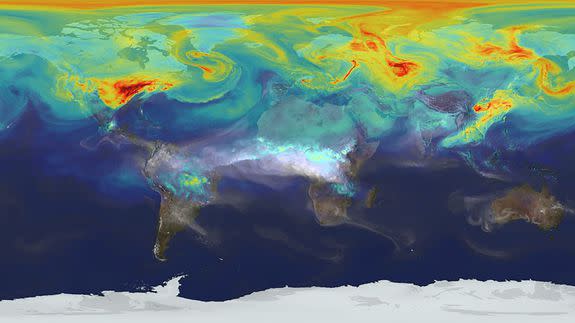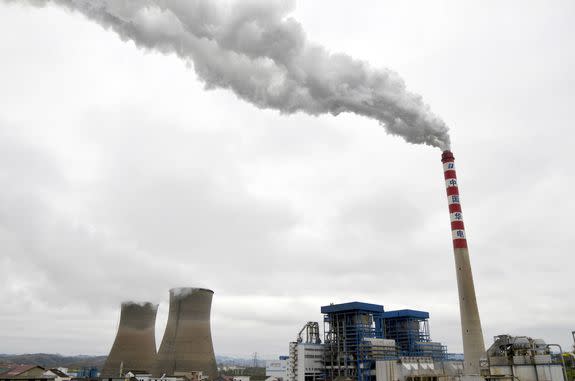A dreaded carbon time bomb lurks beneath your feet

There are many uncertainties when it comes to global warming, from how quickly the planet's ice sheets will melt to how global leaders will enact rapid emissions cuts. One nagging scientific uncertainty concerns a rather unsexy topic: the soil. As in, the ground beneath your feet.
There is growing concern that terrestrial soils, which are the Earth's largest reservoir of carbon outside of the oceans, will switch from being a net absorber of greenhouse gases to a net source.
This can happen as microbes in the soil break down organic matter more quickly, thereby releasing carbon dioxide. As Arctic soils warm, these microbes will go to work there for the first time, emitting what had been carbon frozen in the ground into the atmosphere.
SEE ALSO: Bernie burns House Science Committee after devastating Breitbart tweet
Now, a new study that examined 49 soil warming studies performed in North America, Europe and Asia, has determined that not only will soil carbon feedback be a major player in causing the world to warm faster and more extensively, but that the warming of the Arctic will play a particularly crucial role in determining how much carbon is released.
This research is especially significant since gaining a better understanding of how much carbon will be released from the soils in future decades is critical for accurately predicting global warming in the first place.
The majority of the planet's terrestrial carbon is stored in the soil, where plants deposit it through photosynthesis. These soils release that carbon back to the atmosphere as carbon, methane and other greenhouse gases when organic matter decomposes.
Global warming will affect both the deposition and release of carbon, making the net result an important parameter for predicting future climate change.
For example, in the Arctic, a region warming at about twice the rate of the rest of the world, abundant amounts of soil carbon is currently locked away in frozen ground known as permafrost.
However, recent warming is thawing that permafrost, which is exposing more soils to microbial decay, and therefore increasing terrestrial emissions.
The study, published on Thursday in the journal Nature, found that so much carbon dioxide may be released from the globe's soils by the year 2050 that it would equal the emissions from the United States.
In other words, we not only have to worry about our own emissions from power plants, cars and other sources, but after a certain point in climate change, the planet itself will be a source of carbon.
The new research, published by an international team of nearly 50 scientists, found that soil carbon losses from Arctic soils, where carbon amounts are especially high, are likely to tip the scale toward more carbon being lost from the planet's soils than plants can deposit through photosynthesis.

Image: Jin yunguo - Imaginechina
The study estimates a net release of 55 petagrams, or about 55 billion tons of carbon, if global warming is limited to 2 degrees Celsius, or 3.6 degrees Fahrenheit, compared to preindustrial levels. This means about a 17 percent boost on top of the amount that humans are likely to emit through 2050, the study found.
Uncertainties in the estimates could mean that carbon emissions actually turn out to be much greater, or somewhat less, than projected in the paper.
The key point, though — and it's an unsettling one — is that soils will go from a net sink of carbon dioxide to a net source, and a big one at that.
"Scientists have been concerned for many years that warming may initiate a reinforcing feedback whereby warmer soils emit more carbon," study author Thomas Crowther told Mashable via email.
"We provide the first study to confirm the existence of this feedback at a global scale, showing that will contribute to rising atmospheric carbon dioxide concentrations over the next century," he added.
As the study indicates, this soil feedback has not been incorporated into computer models used to project future climate change, raising the possibility that such models are underestimating the amount of warming that is likely to occur.
"There will be huge amounts of carbon emitted into the atmosphere over the next few decades, and this will undoubtedly contribute to on-going climate change," Crowther, who is a researcher at the Netherlands Institute of Ecology, said.
He said, although uncertainties exist regarding the size of the soil feedback, these questions should not hinder us from acting to reduce greenhouse gas emissions in the meantime.
"If you walked out in front of a bus moving at 50 miles per hour, no doctor could tell you exactly how many bones you will break," he added. "But this medical uncertainty shouldn't discourage you from avoiding moving busses in the future. In the same way, know that climate change is going to be devastating. So we should do our best to avoid it."
Some studies have shown that plant growth will accelerate in a world with more greenhouse gases and increased temperatures, but this may not be enough to offset the freeing up of carbon from soils.
However, scientists have been working to improve agricultural techniques in ways that enhance the absorption of carbon, which could help avoid a worst case scenario at least.
